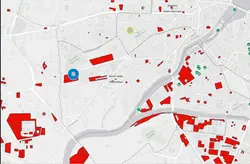GENEVA
Creating a circular hub at the ZIC site

About the pilot area
The Zone Industrielle de Charmilles - or “ZIC” - was once a hub of industrial activities that made precision physical instruments, textiles, and watchmaking. Today, it thrives with small and medium-sized enterprises engaged in traditional and digital craft production, encompassing wood- and metalworking. The ZIC, with a 22,000 square-meter-area is located in Saint-Jean Charmilles, a district that presents a remarkable amount of greens pace accounting for 34.7% of the total area, with a population density of 16,852 people per square kilometer.

ZONE INDUSTRIELLE DES CHARMILLES
In Geneva, the ZIC plays a multifaceted role as a local production center, loop closer for local materials but also a repair and reuse hub. While it is not officially listed as a heritage site, neighborhood representatives, the creative community and the institutions present in the surroundings collectively work towards protecting the history of the former industrial space currently owned by the Geneva municipality. Yet, the area faces challenges such as the potential for soil pollution, generation of waste of construction activitiers, higher-than-average share of low-income employment and a shortage of space for industrial activities.
Led by Ressources Urbaines RU and Onl’fait OLF, the Geneva pilot team created a detailed cartography of the local makers, craftspeople, artists and businesses currently active around the Manufacture Collaborative MACO hub in the ZIC. By mapping and interviewing local ZIC stakeholders on their resources, the pilot team identified several available material resources that could be integrated in a circular value chain. Next to the detailed inventory of local makers, our pilot team has also mapped the city-wide flows of construction waste to understand how the makers of the ZIC can tap into and contribute to a more circular economy at a city-scale.
FOLLOW GENEVA'S CARTOGRAPHY JOURNEY
Which insights have been gathered by our local context detectives?
Read through our gallery of local anecdotes, research findings and in-depth analysis
Parallel to Geneva’s efforts to understand city and neighbourhood-wide urban challenges, the team has embarked on a journey to get to know the local maker community, their resources and concerns
Who was mapped
Craftspeople, artists and creative businesses in the ZIC building
Circular textile businesses in the city
Why?
-
The Geneva pilot was interested in two themes: Firstly, La Maco - a collaborative manufacturing association - was interested in mapping all stakeholders that currently share the ZIC building with the goal of getting a better understanding of the resources and needs of local businesses. Secondly, Le Geste, an organization focussed on textile artisans and training, focussed on mapping textile businesses which have experience in circular business models, sustainable clothing design and recycling.
How was it useful for the Geneva pilot team?
-
The ZIC Maker map was an important tool for the pilot to showcase to others about the diversity of makers present at the ZIC. The map also served as an internal overview dashboard for La Maco
-
The Textile Map of Le Geste aimed at building a better understanding of the city’s circular textile ecosystem
The mapping of makers in Geneva was done by a dedicated team member who used an interview guide in informal conversations with makers.
What local resources were mapped?
Waste materials
Skills & knowledge
Machines
What else was asked?
-
Barriers to implement circular business model
How was data collected?
-
Interviews
Lessons learned
-
Trust building is a long and tedious process. When asking for mapping resources, especially waste streams and skills, it is important to clearly state what the added benefit of resource sharing can be for the stakeholders. In Geneva, for example, the pilot discussed options for a shared waste collection system for all local businesses under the roof - this could save individual businesses time and money.
Which circular opportunities were identified or explored for further research?
-
Biochar from local wood waste - during the mapping process, Geneva’s pilot team identified several sources of wood waste, such as scrap wood, wood chips and saw dust from a mobile saw mill and several artisans. Simultaneously, we mapped a small onsite urban forest on formerly polluted land. To regenerate soils, store carbon and reuse wood waste, the pilot is now exploring biochar technology that can process wood waste and simultaneously generate heat that can be used in the building.
-
Shared waste collection system - to date, waste is brought to recycling sites by all makers individually. This is costly, takes time and also emits CO2 from several trips to recycling sites. Together with the pilot, the ZIC is now exploring options for a centralized waste collection and sorting station.
GALLERY
 |  |  |
|---|---|---|
 |  |

